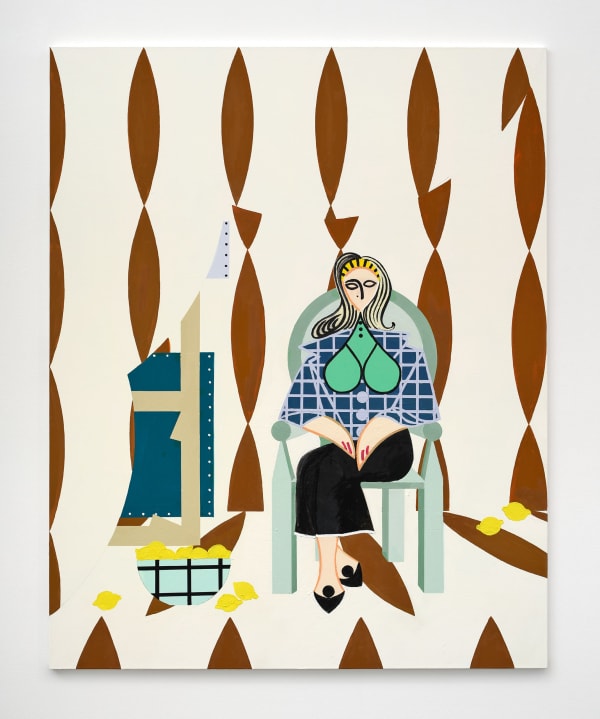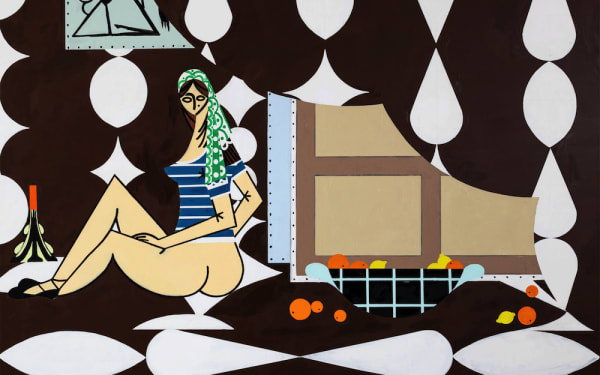Farah Atassi: Mechanical Cabaret
François Ghebaly is proud to present Farah Atassi’s Mechanical Cabaret, the Paris-based artist’s latest exhibition at the gallery’s Downtown Los Angeles location.
French-Syrian artist Farah Atassi’s intricately composed paintings are in direct and open conversation with the world of the modernists. In gridded planes and vivid, staccato geometries, her works recast the feminized subjects of modernist painting—the bather, the female nude, the still life—within her own visual universe and sensibility. The latter, engaging with the legacies of modernist masters like Braque, Schlemmer, Picasso, and Léger, comprises a signature formalist vocabulary for Atassi, through which she interpolates elements of abstraction. For her newest exhibition at François Ghebaly, entitled Mechanical Cabaret, Atassi offers two distinct though interrelated bodies of work, each demonstrating her recent explorations in composition and art-historical genealogy.
The first series within Mechanical Cabaret reexamines the classical figurative painting archetype of the “model in studio.” In works like Seated Woman with Yellow Hair (2023) and Reclining Woman with Roses (2023), Atassi situates her models on a stage populated by the familiar objets of still-life and studio scenes: jardinieres hold geometric green foliage; canvas stretchers peek out from under voluminous, patterned drapery; yellow citrus are arranged in bowls on the ground or strewn across the floor. Eschewing inspirations from real life, Atassi uses paintings themselves as her points of reference. In her words, the works “become an echo of the modernist setup—a staged proposition” through which she directly considers the inventedness and “theater” of representation in painting, as well as her own ambiguous relationship to figuration. Also notable in these works is Atassi’s use of immense, all-over patterning. Square grids, ellipses, and paisley-esque designs enfold the floors and backgrounds of her scenes, sometimes even repeating in the figuration ofbodies or clothing. This effect reinforces a sense of flatness and foreshortening in Atassi’s compositions, opening dichotomies between the sprawl of her largest canvases and the compression of depth and space.
The second body of work in the exhibition, which represents a new series in Atassi’s practice, takes inspiration from Fernand Léger’s seminal post-cubist film Ballet mécanique (1924), as well as from the work of avant-garde animator Oskar Fischinger. Across the exhibition, Atassi’s work presents individual ideas or leitmotivs in “a multiplicity of statuses” within a single composition. Here, she shows special interest in the representation of the body as object, decoration, and even setting. In works like Mechanical Cabaret 3 (2023), intricate background draperies and geometric appliqués resemble the contours of breasts, buttons, laces, and a collar, suggesting the silhouette of a figure’s chest. Elsewhere, Atassi styles elongated dancers’ legs like the porcelain appendages of 19th century automatons–recalling the French “can-can,” Toulouse-Lautrec, and the glittering underworld of Parisian cabaret. Punctuating the choreography of Atassi’s dancers are, once again, fragments of still-life: a pyramid of oranges, a tambourine, a woodwind.
In the context of Mechanical Cabaret, these elements, like the canvas stretchers in her studio backgrounds, or the thin wires suspending props in her cabaret scenes, underscore Atassi’s recurring interest in the play between dynamism and ornamentality, depth and compression, subject and object, and ultimately point toward the illusions at the heart of the modernist image.
Farah Atassi (b. 1981, Brussels, Belgium) lives and works in Paris, France. Recent solo exhibitions include François Ghebaly, Los Angeles (2023, 2020, 2017); Musée Picasso, Paris (2022); Almine Rech, Shanghai (2022), Paris (2020), New York (2019); Le Consortium, Dijon, France (2020, 2019); Musée des Beaux-Arts de Cambrai, France (2018); Museum Permeke, Jabbeke, Belgium (2018); and Contemporary Art Center, Le Havre, France (2014). Her work was included in group presentations at Musée des Beaux Arts de Lyon, Lyon, France (2020); National Museum of Art of Romania, Bucharest (2019); Moscow International Biennale of Contemporary Art, Russia (2017); Biennale of Painting, Roger Raveel Museum, Machelen-Zulte, Belgium (2016); Musée d’Art Moderne et Contemporain de Strasbourg, Strasbourg, France (2016); Centre Pompidou, Paris (2014), Hyogo Prefectural Museum of Art, Kobe, Japan (2014) and Palais de Tokyo, Paris (2010).
-
 Farah Atassi, Reclining Woman with Roses, 2023
Farah Atassi, Reclining Woman with Roses, 2023 -
 Farah Atassi, Seated Woman with Yellow Hair, 2023
Farah Atassi, Seated Woman with Yellow Hair, 2023 -
 Farah Atassi, Seated Woman with Yellow Hair 2, 2023
Farah Atassi, Seated Woman with Yellow Hair 2, 2023 -
 Farah Atassi, Seated Woman with Yellow Hair 3, 2023
Farah Atassi, Seated Woman with Yellow Hair 3, 2023 -
 Farah Atassi, Mechanical Cabaret 4, 2023
Farah Atassi, Mechanical Cabaret 4, 2023 -
 Farah Atassi, Mechanical Cabaret 2, 2023
Farah Atassi, Mechanical Cabaret 2, 2023 -
 Farah Atassi, Mechanical Cabaret, 2023
Farah Atassi, Mechanical Cabaret, 2023 -
 Farah Atassi, Mechanical Cabaret 3, 2023
Farah Atassi, Mechanical Cabaret 3, 2023











